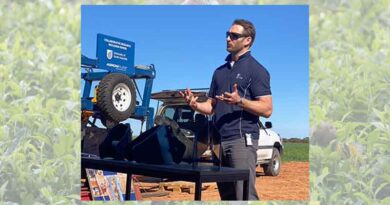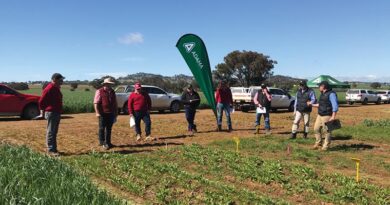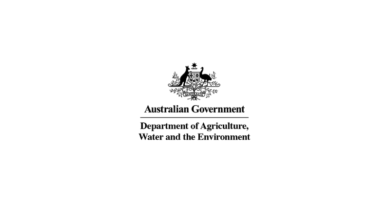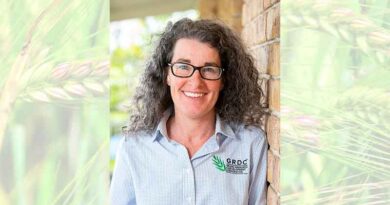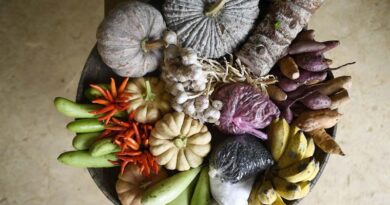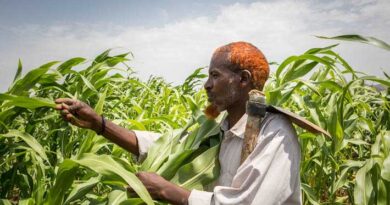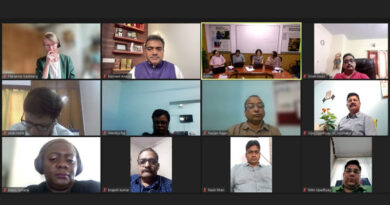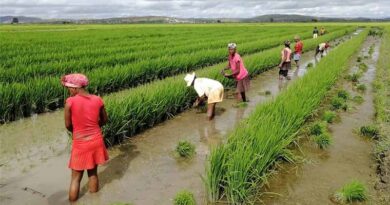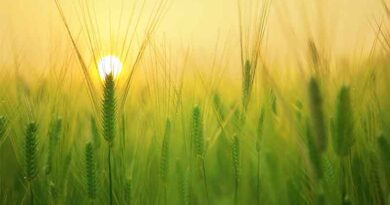Innovation and improvements the way ahead for growers
21 March 2023, Australia: Each year, GroundCover™ follows a group of growers from across Australia as they manage the cropping season. In this first instalment for 2022, staff writers introduce this year’s participants.
South Australia
James Venning, with his wife Lauren and parents Max and Therese, runs Barunga Grains at Bute, on South Australia’s Yorke Peninsula. Enterprises include wheat, lentils, canola, barley and some lupins (in parts of paddocks where lentils cannot be grown).
Farm size: 4700 hectares
Average annual rainfall: 400 millimetres
Professional advice: Sam Trengove Consulting
Memberships: Northern Sustainable Soils, Hart Field Site Group, Grain Growers, Grain Producers SA
Key changes (in recent past): Variable-rate application of seed, fertiliser, lime and gypsum. Managing the farm via zones rather than treating paddocks all the same. Changing from growing break crops for wheat to using cereals as a break crop for lentils and canola.
2023 goals: Probably much the same as the past few years, where the focus has been on pushing lentils into more unfavourable soils (by fixing them). More generally, managing all crops in a timely fashion, and continually learning.
Challenges and opportunities: With rising input, land and machinery costs, making every dollar invested work to its maximum – whether that be applying inputs where an economic response is expected or doing more with less in terms of machinery (balancing timeliness with not being overcapitalised).
R&D wishlist: It is very important to always keep innovating. But the core always has to be farm profitability because if farmers are profitable, the rest takes care of itself (such as affording to take on things such as carbon regulation, which will likely come).
More work on newer, more-water-soluble chemistry and the southern and western region’s sandier soils. We find chemical companies are doing their Australian Pesticides and Veterinary Medicines Authority trials on heavier soils and masking the issues associated with a large area of Australian soils. Understanding compaction/hard setting, and the role controlled-traffic farming has (does it recompact anyway?).
Victoria
Mick Pole runs a cropping property at Walpeup in north-western Victoria. Enterprises include wheat, barley, lentils, occasional canola, as well as vetch, lupins and peas for brown manure.
Farm size: 6000ha
Average annual rainfall: 330mm
Professional advice: Independent chair, agronomist/business consultant
Memberships: Mallee Sustainable Farming, Birchip Cropping Group, Victorian Farmers Federation, Grain Growers
Key changes (in recent past): Collaborative farming model with friend and neighbour Jim Wakefield in 2015, from previously farming with parents. Adopting and fully implementing 15-metre controlled-traffic farming in 2020. Deep ripping in 2019. Camera spraying with shield and summer spraying in 2022.
2023 goals: Progress with learning and implementing technology that’s currently on-farm and optimise where things haven’t been performing. Fine-tune zones for variable-rate-control fertiliser applications, and have variable-rate-control ripping map operational to deep ripper hydraulics.
Challenges and opportunities: In the short term – and possibly for a few years to come – fixing the effect and mess made by the spring of 2022’s big wet. Trafficability on some paddocks will cause issues with efficiency of spraying and sowing this year as areas are so wet. (This also leads into a great opportunity with a full profile of water.)
Another challenge in the short and long term is to adjust from what appeared high-risk farming last season, in what is traditionally a low-rainfall, low-risk environment. The likelihood of drier times ahead, with input costs still historically very high – along with machinery costs – continues to press home how important our choices are in crop selection, rotation, efficiency of implementing a plan and machinery purchases.
Each season seems to find a way to challenge us, but with the advancements in research, technology and good advice, we are continuing to build confidence in our system, business and farm.
R&D wishlist: The changing dynamics of research and how it comes about, as well as how it’s progressed over the past 20 years, has been an interesting journey. Local research is critical. Length of projects is critical. Long-term local projects of new possibilities are paramount – giving researchers and farming groups stability and confidence into the future, which ultimately gives growers the confidence to implement relevant research and increase profit and sustainability.
Soil amelioration has been and will continue to be a big topic, but still has many more years to go in how things react, manage, grow and change.
Queensland
Nigel Corish and his family run New Leaf Ag at Condamine on Queensland’s Western Downs, bought in 2017 after a move from Goondiwindi. The main enterprises are dryland and irrigated cereal and cotton cropping.
Average annual rainfall: 550mm, although more than one metre of rainfall was recorded last year
Farm size: 4000ha of dryland cropping run on a five-year rotation that includes wheat, chickpeas, barley, sorghum and cotton; and 450ha of irrigated cotton and cereal cropping
Professional advice: MCA Ag agronomists Tim Richards, Frank Valentine and Sam Castor, and Independent Commodity Management’s Matt Leeson
Memberships: Grain Growers Association board member and Nuffield Australia
Key changes: In the past five years, we have undertaken contouring work to improve water infiltration. This has been done with MCA, which undertook light detection and ranging (LiDAR) work. LiDAR scans help create a 3D topography survey for farm elevation analysis. We knew we would have to re-level our dryland cropping areas, especially our melon hole country, and had planned for this when we purchased the property in 2017. The exercise has been expensive but worth it. We have noticed yields are 1t/ha higher due to better water infiltration. I would say we have had our best result ever on our wheat, averaging 5.4t/ha.
We have also undertaken a fair bit of deep ripping coinciding with our five-year rotational plan. We tend to do 500ha a year when we are coming out of cotton or sorghum and also put down 10t/ha of manure. Although we had planned the contouring work as a capital expense, we hadn’t factored in the deep ripping. It was a surprise because we have always been minimum-till, but when we sold our previous property at Goondiwindi, we went from heavy black soils to brigalow country.
We have also been focusing on weeds, especially fleabane and feathertop Rhodes grass. We double knock and use our WeedIT, an important part of the farm business. We have had it for three years now and it has been a game-changer in terms of weed control.
2023 goals: We want to make sure we deliver and keep investing in these improvements. We had a good winter crop in 2022 and we need to utilise that, including the stubble cover. The farm is in good shape, so we want to keep the momentum there. I also want to focus on sustainability, efficiencies where possible, and potential carbon projects.
Challenges and opportunities: Rainfall is always a challenge. We need to be ready for the next drought, which is an opportunity too. Weeds continue to be a challenge, as do input costs. They are 30 per cent higher than we have ever seen before, so we need to look at the margins going forward and consider different nitrogen sources.
R&D wishlist: All of the above, but the next challenge is sustainability – where are the efficiencies going to come from? Where can we find fertiliser and water efficiencies? Can we be in a carbon-neutral place in the future? And, on top of all that, how do we increase profitability? We need to think about continued yield and disease improvement in our varieties. This is important.
New South Wales
Broden Holland and his family grow dryland wheat, canola and 6000 wether sheep near Thuddungra, north-west of Young in southern New South Wales.
Average annual rainfall: 600mm
Farm size: 5000ha, with 4400ha cropped
Professional advice: Delta Agribusiness agronomist Dave Crowley and Rural Management Strategies director and business consultant Robert Patterson
Memberships: Kondinin Group and FarmLink Research
Key changes: We have adopted a variable-rate system for all inputs across the farm. We are heavily focused on the proactive and timely application of fungicides to protect crops against disease.
2023 goals: Long-range weather forecasters predict an average season this year with a tighter finish, so we plan to set up our crops to maximise the water they use to achieve a reasonable yield, with the elevated frost risk that comes with a drier finish. We will minimise early growth by targeting conservative plant numbers to ensure crops fill. The targets are 350 heads per square metre for wheat and 30 heads/m2 for canola.
Challenges and opportunities: Frost in dry years, lodging in wet years, and keeping weed numbers low while also reducing the money spent on expensive herbicides. Our weed numbers are low, but we have to spend money on herbicides to keep them in check. Camera spraying is part of our strategy to achieve this. We have been trying to find a pulse crop to replace lucerne. Next year, we will grow faba beans.
R&D wishlist: Frost is still a challenge for us, so continued investment in that space is a priority. Moving hyper-yielding research from ‘reliable’ high-rainfall areas to medium-rainfall areas, where some years are more challenging. An increased focus on solving the problem of lodging with large in-paddock trials (rather than plot trials) so we can reliably achieve higher yields for wheat (8t/ha) across more seasons.
Western Australia
Wayne and Jody Pech run North Stirling Downs Agriculture in WA’s Great Southern region. Established in 1961, the business is a mixed farm focusing on sustainable production of high-quality food and fibre. It employs seven staff.
Average annual rainfall: 350mm, but closer to 480mm in the past couple of years
Farm size: 13,000ha over four properties in a triangle from Gnowangerup to Cranbrook and North Stirlings
Professional advice: Mentor, farm adviser, independent grain marketer, human resources and workplace health and safety (WHS) consultant, accountant, Stirling Ag, Nutrien Ag Solutions for agronomic and chemical recommendations, Elders Cranbrook for sheep husbandry and fertiliser supplies
Memberships: AgZero 2030
Key changes: Business emphasis has shifted from 50:50 cropping to stock to 60:40 in recent years as stubbles ran out over summer as a source of stock feed. The increase in the cropping proportion, which is creating more stubble, is now benefiting the stock and they are able to maintain numbers by turning stock off earlier.
2023 goals: In early February, Wayne was busy preparing presentations for the GRDC Business Updates on his experiences with carbon farming. For four years he has been working with Integrity Ag in Toowoomba to measure and lower carbon emissions to make his business more sustainable. A continued focus is enabling staff to farm while Wayne concentrates on business development (finalising a farm business and management manual), human resources and WHS.
Challenges and opportunities: Sourcing farm labour has become a challenging issue and Jody and Wayne are addressing this by establishing a social presence for their business with a website and regular social media posts. Wayne says it is about promoting the business as an innovative, caring and sustainable place to work as recruitment is very competitive.
R&D wishlist: As the window for achieving good returns from high-protein cereals is getting smaller, Wayne would like to see breeding companies chasing varieties with much-higher yield potential. He also says there are grey areas and inefficiencies in the collection of end point royalties and would like to see this system reviewed.
Also Read: Diageo India launches regenerative agriculture program in Punjab and Haryana farmers
(For Latest Agriculture News & Updates, follow Krishak Jagat on Google News)


